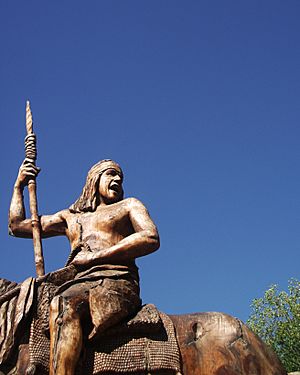Pelantaro facts for kids
Quick facts for kids
Pelantaro
|
|
|---|---|

Statue of Pelantaro in the Site Museum of the Fort of Purén.
|
|
| Rank | Toqui |
| Battles/wars | Battle of Curalaba |
Pelantaro or Pelantarú was a brave leader of the Mapuche people. His name, Pelantaro, means "Shining Caracara," which is a type of bird. He was a toqui, which means a military leader, during a big uprising by the Mapuche people in 1598.
Pelantaro and his helpers, Anganamon and Guaiquimilla, are famous for defeating the Spanish Governor of Chile, Martín García Óñez de Loyola. This happened during the Battle of Curalaba on December 21, 1598.
This victory made the Mapuche and other local groups rise up against the Spanish. They managed to destroy many Spanish towns and forts south of the Bio-bio River. Some towns north of the river, like Santa Cruz de Oñez and San Bartolomé de Chillán, were also destroyed in 1599. After these events, the new Spanish Governor, Alonso de Ribera, decided to set a border. He also listened to a Jesuit priest named Luis de Valdivia, who suggested a "defensive war" approach.
Pelantaro's Trophies
Pelantaro once had the heads of two important Spanish leaders, Pedro de Valdivia and Martín Óñez de Loyola. He kept them as symbols of his victories. But in 1608, to show that he wanted peace, he gave them back.
Capture and Release
In 1616, Pelantaro was captured by the Spanish. He was held for about a year and a half. After the Spanish Governor Alonso de Ribera died, the next governor, Fernando Talaverano Gallegos, decided to release Pelantaro. This was an attempt to make peace with the Mapuche people, but it didn't work out as hoped.
See also
 In Spanish: Pelantaro para niños
In Spanish: Pelantaro para niños
Images for kids
Sources
- Colección de documentos inéditos para la Historia de Chile, segunda serie, tomo VII, 1600–1606, Primer gobierno de Alonso de Rivera, publicadas por el Fondo Histórico y Bibliográfico de J. T. Medina, Santiago de Chile, 1982.
- Crescente Errázuriz, Seis años de la historia de Chile (23 de diciembre de 1598 – 9 de abril de 1605), Tomo I y II, Imprenta Nacional, 1882–1908.
- Alonso González de Nájera, Desengaño y reparo de la guerra de Chile, Editorial Andrés Bello, Santiago de Chile, 1971.
- Diego Ocaña, Viaje a Chile: relación del viaje a Chile, año de 1600, contenida en la crónica de viaje intitulada “A través de la América del Sur”, Colección Escritores Coloniales, Editorial Universitaria, 1era. Edición, Santiago de Chile, 1995.
- Alonso de Ovalle, Histórica relación del Reino de Chile y de las misiones y ministerios que ejercita en él la Compañía de Jesús ..., Reproducción digital de la edición de Roma, Francisco Caballo, 1646, Alicante : Biblioteca Virtual Miguel de Cervantes, 2007.
- Roger Arteaga Cea PELANTARO: el gran toqui de Purén


